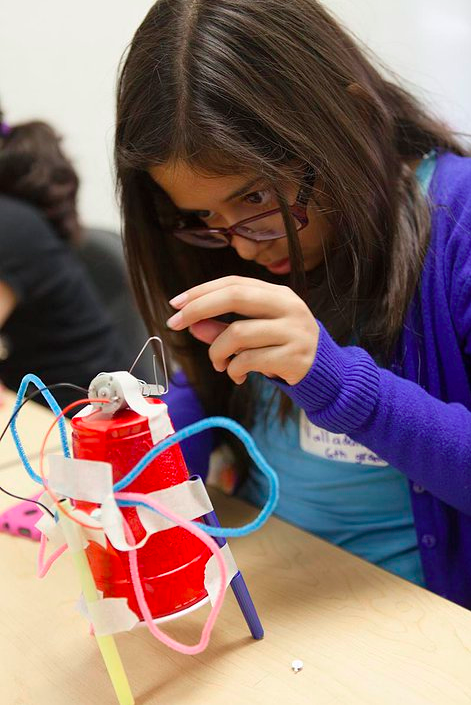Latinas in STEM: Making Bright Futures a Reality
Submitted by Mónica Ivelisse Feliú-Mójer on
During National Hispanic Heritage Month, Ciencia Puerto Rico and Borinqueña are celebrating the work of organizations inspiring, supporting and empowering Latinas in STEM fields. You can read this profile in Spanish here.
Latinas have a bright future in science, technology, engineering and mathematics (STEM). Latina girls love learning how things work. They love building things. They think it would be fun to design a video game or an app. Unfortunately, they have less opportunities and resources to make that bright future a reality1.
The Latinas in STEM Foundation is leveraging family, culture and community to change that. Founded in 2013 by five alumnae from the Massachusetts Institute of Technology (MIT), the organization aims to inspire young Latinas to pursue careers and thrive in STEM fields.
“We want to spread awareness about STEM and to encourage Latinas in K-12 grades, especially within underserved communities, to strongly consider pursuing a STEM career,” says Diana Albarrán Chicas, an electrical engineer who is a co-founder and the financial director of Latinas in STEM. Fellow co-founders are Noramay Cadenas, Luz Rivas, Jazlyn Carvajal and Veronica Garcia.
Inspire, Pursue, Thrive
The founders of Latinas in STEM Foundation felt there was a need for a “for Latinas, by Latinas” approach because as Latinas working in STEM industries “we see the brutal reality of the statistics… we really wanted a way to outreach directly to the community and increase the number of Latinas entering STEM fields,” says Noramay Cadena, co-founder and executive director of the organization. In the United States, Latinas make up just 2% of the STEM workforce (they represent 8.1% of the U.S. population)2.
These five successful Latinas were inspired to pursue careers in STEM by hearing about the experience of people like them, working in STEM fields. Now they want to pay it forward by inspiring the next generation of Latinas in STEM.
To achieve this, the Foundation has established programs that impact the lives of girls and young women, from primary to higher education to professionals.
The STEM 101 conferences (recently held in New Jersey, California and Texas) include hands on workshops in which middle and high school girls can build robots or prototype mobile apps. These conferences also include workshops to help students explore STEM fields, prepare for college admissions and the financial aid process and provide them with advice on how to succeed as Latinas in STEM fields.
Latinas in STEM also offers the Summer Enrichment Program, involving elementary students (3rd to 5th grades) with hands-on workshops that allow students to explore chemistry by making their own shampoo or engineering by building bridges.
Although many of their programs so far have focused on school-aged girls, Latinas in STEM is currently working on reaching out to college students and professionals.
“We also seek to help Latinas in STEM thrive in their college and professional careers by providing mentorship, networking and recognition opportunities,” adds Albarrán Chicas.
Recently, they hosted STEM Night, a networking event sponsored by El Camino College and Chevron, for professionals, educators and non-profits. Latinas in STEM is also having a college and professional membership drive that is meant to help them connect to Latinas in STEM fields around the country.

A girl builds a robot during a STEM 101 event in Dallas, Texas.
Familia, cultura y comunidad
Cultural and family values have strong influence on Latina girls’ decision to go to college and pursue a career in STEM. Family support and encouragement have been shown to be important for persistence of Latinos/as in STEM fields3.
Unfortunately, Latino parents and families are often unable to provide their children with the academic, financial and emotional support they need to get through to finish a career in STEM4,5.
“We aim to not only educate students, but most importantly their parents so that they may be better positioned to support their daughters along this challenging journey,” asserts Albarrán Chicas.
During the STEM 101 conferences, Latinas in STEM offers bilingual workshops for parents that focus on why STEM fields are thriving, the college admissions and financial aid process, and the importance of supporting/encouraging their children to pursue STEM fields.
Whenever they hold a workshop or a conference, Latinas in STEM taps into the local community of STEM professionals to facilitate workshops and serve as volunteers. Many of these professionals are Latinas and Latinos, providing attendees with role models that look like them, who are part of their community.
“We have been fortunate to have many supporters along the way, including all of our local STEM professionals, the volunteers who logistically have helped our conferences run smoothly. Our growing membership has also been very valuable in supporting our current efforts and our new initiatives. We have had great support from our many partners and educational institutions that believe in our mission,” asserts Albarrán Chicas.
Their work is having great impact. To date the Latinas in STEM Foundation has reached over 2,200 girls, 350 parents, and 550 professionals.
“Throughout our conferences parents and students have approached us, thanking us for bringing our conferences to them and explaining why STEM is important. The most common question is always: will you be coming back next year? There is something priceless about hearing how grateful the students and parents are with our efforts,” concludes Albarrán Chicas.
References:
- Modi, Schoenberg & Salmond (2012). Generation STEM: What Girls Say About Science, Technology, Engineering and Mathematics, p. 20-24. Girl Scouts Research Institute.
- Women, Minorities and Persons with Disabilities in Science and Engineering (2013). National Science Foundation.
- Garcia and Hurtado (2011). Predicting Latina/o STEM Persistence at HSIs and non-HSIs. Downloaded on September 14th, 2014 from: http://ow.ly/BuymQ.
- Taningco, Mathew, & Pachon (2008). STEM Professions: Opportunities and Challenges for Latinos: A Review of Literature. The Tomás Rivera Policy Institute.
- Villegas, M.A.S, and Vincent, K.M. (2005). Factors that Influence the Underrepresentation of Latino/a Students Majoring in Mathematics in the State of Washington. WSU McNair Journal, 3, 114-129.









